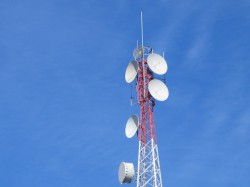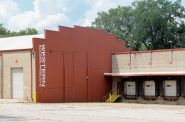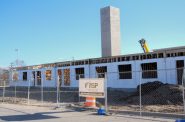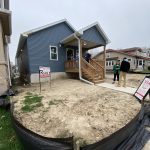Locals Can’t Prevent Huge Broadcast Towers
Rule quietly tucked into state budget ends local power to restrict broadcast towers.

Broadcast Tower by Steven Beger Photography (beger.com Productions)
It was the perfect piece of land for their dream home. Fifty acres in the town of Rutland, in rural Dane County, a few miles south of Madison. Jessica Polakowski and her husband, Nicholas, closed the deal on Sept. 7, 2010.
Later that same day, Jessica recalls, the couple learned that Magnum Communications, a Tomah-based broadcast company, wanted to erect a nearly 500-foot radio tower on an adjacent plot. The application was filed in November 2010.
The Polakowskis were stunned. The tower would be almost twice as tall as the state Capitol, visible for miles. There would be blinking lights and guy wires — even the possibility of collapse, as happened with a broadcast tower in Eau Claire.
Town and county approval was required, and the couple joined other foes at public hearings. “Quite a crowd turned out for these,” Jessica says.
There was also support, from officials in communities that would be served by the tower, including the cities of Stoughton and Verona. But it wasn’t enough.
In 2011, the town rejected the application and the Dane County Board followed suit. Among other things, the town deemed that the tower would have a negative impact on the uses, value and enjoyment of nearby property.
The Polakowskis proceeded to build their dream house — the property and home now have an assessed value of more than $450,000 — but the battle was not over. Magnum sued the town and county, seeking to overturn the denial.
Last September, Dane County Judge William Foust ruled that local officials were within their rights to reject the application.
On Feb. 20, Magnum Communications submitted a new application for a 486-foot tower in the same location. That’s two feet shorter than before, and the structure may contain fewer lights. But the proposal is essentially the same.
The difference is that, this time, it stands a much better chance.
That’s because a provision passed in last year’s state budget bill greatly restricts the ability of local communities in Wisconsin to reject broadcast towers. Any denial must now be based solely on public health or safety concerns, backed with “substantial written evidence.”
Reflects town of Rutland chairman Dale Beske, “The rules of the game are changed after the game is over and you have to replay the game.”
Drafting records tie this new provision, and one making it harder for local governments to spurn cell phone towers, to state Rep. John Klenke, R-Green Bay. Klenke did not respond to requests for comment.
Magnum Communications reported spending about four hours in early 2013 lobbying on “broadcast siting.” Contract lobbyist Forbes McIntosh and company head Dave Magnum passed up opportunities to comment. Magnum, a two-time unsuccessful Republican candidate for Congress, has given $7,000 to GOP state candidates and parties since 2009.
Bill White, an attorney for Michael Best & Friedrich, which has represented Magnum on the Rutland tower, acknowledges the company’s involvement in the legislative process: “We tried to make sure that the concerns and benefits of broadcast media were known to the Legislature.”
While not predicting an automatic win, White says the budget provision “does make a difference in terms of the approval process.” He thinks the change makes sense because radio towers serve the public interest, as part of a broadcast network used during weather and other emergencies. Hence the support for the Rutland tower from places like Stoughton.
But Polakowski disputes there’s any unmet public safety need the tower would fill, adding, “If the city of Stoughton feels there’s a need for a radio tower, there’s plenty of land in Stoughton.”
Bill Lueders is the Money and Politics Project director at the Wisconsin Center for Investigative Journalism (www.WisconsinWatch.org). The Center produces the project in partnership with MapLight.
The Center collaborates with Wisconsin Public Radio, Wisconsin Public Television, other news media and the UW-Madison School of Journalism and Mass Communication. All works created, published, posted or disseminated by the Center do not necessarily reflect the views or opinions of UW-Madison or any of its affiliates.
-
Wisconsin’s Medicaid Postpartum Protection Lags Most States
 Feb 27th, 2024 by Rachel Hale
Feb 27th, 2024 by Rachel Hale
-
Wisconsin Has A “Smart Growth” Law To Encourage Housing, But No One Is Enforcing It
 Dec 22nd, 2023 by Jonmaesha Beltran
Dec 22nd, 2023 by Jonmaesha Beltran
-
Milwaukee County Is Funding Affordable Housing In Suburbs
 Dec 21st, 2023 by Jonmaesha Beltran
Dec 21st, 2023 by Jonmaesha Beltran

















I’m curious, how are these towers treated differently than windmills? or cell towers?
Another example of a corporation buying votes. The individual doesn’t stand a chance of being equally represented.
This is good. We can’t let the rights of those wealthy land owners get in the way of serving all the residents in the area who are served by this radio tower. What if an emergency needs broadcasting? If we need to get a message out, the last thing that should stop that is the pretty views from some rich persons house.
This is a great example of why we should have government making all our decisions for us. It’s for the greater good.
We’ve already witnessed cellular providers petition to build a new tower within 3,000 feet of an existing tower that had available space to co-locate. This was in a rural community and the existing tower was on top of a hill (which would lead one to believe that it produced a substantially better propagation ring). In another case we actually had to point out to the petitioning cellular provider that there was a space to co-locate on a nearby tower. We had to play a middle-man role and get the two parties in touch so that they could work out a co-location agreement. After all, what incentive does cellular Provider X have to find a co-location site owned by Provider Y when statute now allows them to virtually build anywhere they want and create a revenue generating tower for themselves (with more co-location space) simply by paying an engineer to say, “Yeah, we need this tower here, there are no other suitable sites). We’ve literally gotten requests for new tower locations where the rationalization from the petitioner is two sentences. It’s almost like they were testing the water to see if they could get away with constructing a brand new tower for their own benefit a stone’s throw from a viable co-location option.
Bottom line, this is the sometimes ridiculous ebb and flow of zoning law. Corporations and special interests lobbies throw a slider tagged on to some budget bill and after a few arrogant screw ups, a bill is passed in later years reversing the rule. But the damage will be done and communities will be left to live with the few now non-conforming towers that were constructed and now nearly impossible to get rid off, cause something similar to Wisconsin State Statute 59.69(10m) will get passed.